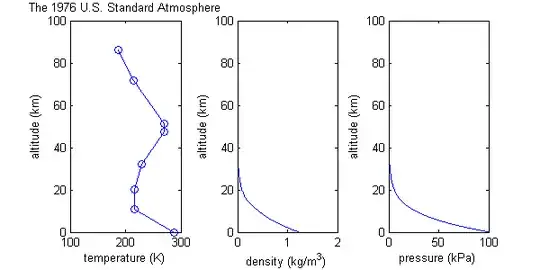At sea level the speed of sound is 760mph, but at altitudes like the Concorde would fly at (55,000ft) the sound barrier is at 660mph, so 1000th slower. Does it have to do with lower pressure?
3 Answers
it has to do with the temperature lapse with altitude. since the speeed of sound is related to temperature by:
$a = \sqrt{\gamma RT}$, where $\gamma$ and R are gas properties and T is temperature
and the temperature profile follows (generally) like the left of these three plots:
The area of interest for airliners is in the lowermost region where the temperature is steadily decreasing with altitude (at a rate of ~6.5K/km)
- 330
A sound wave moving through a gas requires a small scale bulk movement of gas molecules back and forth as pressure at any locations builds or falls. Therefore, the sound wave can not possibly move through the gas at a speed greater than that of the individual molecules themselves, and in fact must move at a lower speed than that due to the random nature of molecular movement. Since molecular speed in a gas is a direct function of average molecular kinetic energy and that is a direct function of temperature, the speed of sound in a gas will also be a function of temperature.
At the cruise altitude of the Concorde the atmospheric temperature is below that of the standard atmospheric temperature at sea level, so the speed of sound is also lower. That is the simple answer.
One might also note that the temperature is lower as one ascends primarily because the pressure is lower as one ascends and then conclude that the speed difference is equally attributable to lower pressure (or lower density for that matter). However, it is primarily and more directly related to molecular speed and thus temperature than it is to anything else.
- 473
From a non-technical viewpoint, I would say that the simplest way I understand this is the following one.
Yes, it has to do with pressure. Actually, it might be easier to think that it has to do with density. Consider the dominoes effect. If the dominoes are more apart from each other, that is, if the density of dominoes is lower, it will take longer for a certain domino to "communicate" to the next one that it has suffered a mechanical push from the previous one. Analogously, if the density of the air is lower, the propagation of the mechanical pulse will take longer, that is, its speed will be lower.
- 32
